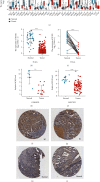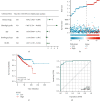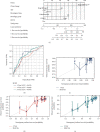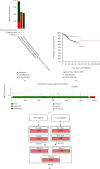BCHE as a Prognostic Biomarker in Endometrial Cancer and Its Correlation with Immunity
- PMID: 35915658
- PMCID: PMC9338740
- DOI: 10.1155/2022/6051092
BCHE as a Prognostic Biomarker in Endometrial Cancer and Its Correlation with Immunity
Abstract
Background: In developed countries, the most common gynecologic malignancy is endometrial carcinoma (EC), making the identification of EC biomarkers extremely essential. As a natural enzyme, butyrylcholinesterase (BCHE) is found in hepatocytes and plasma. There is a strong correlation between BCHE gene mutations and cancers and other diseases. The aim of this study was to analyze the role of BCHE in patients with EC.
Methods: A variety of analyses were conducted on The Cancer Genome Atlas (TCGA) data, including differential expression analysis, enrichment analysis, immunity, clinicopathology, and survival analysis. The Gene Expression Omnibus (GEO) database was used to validate outcomes. Using R tools, Gene Set Enrichment Analysis (GSEA) and Gene Ontology (GO) analyses revealed the potential mechanisms of BCHE in EC. Sangerbox tools were used to delve into the relations between BCHE expression and tumor microenvironment, including microsatellite instability (MSI), tumor neoantigen count (TNC), and tumor mutation burden (TMB). BCHE's genetic alteration analysis was conducted by cBioPortal. In addition, the Human Protein Atlas (HPA) was used to validate the outcomes by immunohistochemistry, and an analysis of the protein-protein interaction network (PPI) was performed with the help of the STRING database.
Results: Based on our results, BCHE was a significant independent prognostic factor for patients with EC. The prognosis with EC was affected by age, stage, grade, histological type, and BCHE. GSEA showed that BCHE was closely related to pathways regulating immune response, including transforming growth factor-β (TGF-β) signaling pathways and cancer immunotherapy through PD1 blockade pathways. The immune analysis revealed that CD4+ regulatory T cells (Tregs) were negatively correlated with BCHE expression and the immune checkpoint molecules CD28, ADORA2A, BTNL2, and TNFRSF18 were all significantly related to BCHE. BCHE expression was also associated with TMB by genetic alteration analysis.
Conclusions: Identifying BCHE as a biomarker for EC might help predict its prognosis and could have important implications for immunotherapy.
Copyright © 2022 Junxiu Liu et al.
Conflict of interest statement
The authors declare that they have no competing interests.
Figures








Similar articles
-
Protein-based prognostic signature for predicting the survival and immunotherapeutic efficiency of endometrial carcinoma.BMC Cancer. 2022 Mar 25;22(1):325. doi: 10.1186/s12885-022-09402-w. BMC Cancer. 2022. PMID: 35337291 Free PMC article.
-
Identification and verification of PTPN3 as a novel biomarker in predicting cancer prognosis, immunity, and immunotherapeutic efficacy.Eur J Med Res. 2024 Jan 3;29(1):12. doi: 10.1186/s40001-023-01587-5. Eur J Med Res. 2024. PMID: 38173048 Free PMC article.
-
Identification and validation of TNFRSF4 as a high-profile biomarker for prognosis and immunomodulation in endometrial carcinoma.BMC Cancer. 2022 May 13;22(1):543. doi: 10.1186/s12885-022-09654-6. BMC Cancer. 2022. PMID: 35562682 Free PMC article.
-
Identify potential prognostic indicators and tumor-infiltrating immune cells in pancreatic adenocarcinoma.Biosci Rep. 2022 Feb 25;42(2):BSR20212523. doi: 10.1042/BSR20212523. Biosci Rep. 2022. PMID: 35083488 Free PMC article. Review.
-
Tumor genotype and immune microenvironment in POLE-ultramutated and MSI-hypermutated Endometrial Cancers: New candidates for checkpoint blockade immunotherapy?Cancer Treat Rev. 2016 Jul;48:61-8. doi: 10.1016/j.ctrv.2016.06.008. Epub 2016 Jun 18. Cancer Treat Rev. 2016. PMID: 27362548 Review.
Cited by
-
The role of ncRNAs and exosomes in the development and progression of endometrial cancer.Front Oncol. 2024 Aug 12;14:1418005. doi: 10.3389/fonc.2024.1418005. eCollection 2024. Front Oncol. 2024. PMID: 39188680 Free PMC article. Review.
-
A combined immunopeptidomics, proteomics, and cell surface proteomics approach to identify immunotherapy targets for diffuse intrinsic pontine glioma.Front Oncol. 2023 Aug 11;13:1192448. doi: 10.3389/fonc.2023.1192448. eCollection 2023. Front Oncol. 2023. PMID: 37637064 Free PMC article.
-
Butyrylcholinesterase (BChE) downregulation in taxane resistance: implications for prostate cancer.Turk J Biol. 2025 Mar 26;49(3):261-272. doi: 10.55730/1300-0152.2743. eCollection 2025. Turk J Biol. 2025. PMID: 40678419 Free PMC article.
-
Effect of Inhibiting Butyrylcholinesterase Activity Using Fractionated Coffee Extracts Digested In Vitro in Gastrointestinal Tract: Docking Simulation and Calorimetric and Studies.Nutrients. 2023 May 18;15(10):2366. doi: 10.3390/nu15102366. Nutrients. 2023. PMID: 37242249 Free PMC article.
-
5'-Guanidino Xylofuranosyl Nucleosides as Novel Types of 5'-Functionalized Nucleosides with Biological Potential.Pharmaceuticals (Basel). 2025 May 16;18(5):734. doi: 10.3390/ph18050734. Pharmaceuticals (Basel). 2025. PMID: 40430552 Free PMC article.
References
MeSH terms
Substances
LinkOut - more resources
Full Text Sources
Research Materials
Miscellaneous

